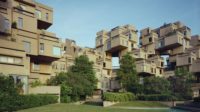Moshe Safdie was an unknown young architect when he led seasoned modernists Philip Johnson, I.M. Pei, and Paul Rudolph on a tour of a half-constructed Habitat 67—the utopian modular-housing system he developed for the 1967 World’s Fair in Montreal. An adaptation of his thesis project at McGill University, the 158-unit complex, composed of prefinished concrete cubes in staggered formation, married urban density with the spaciousness and individuality of suburban houses. “After that, Rudolph was transformed,” Safdie told RECORD recently. “We all recognized that this was a radical idea.” Still, today, Habitat remains one of the most momentous experiments in prefab housing and urban planning. And although it never flourished as a viable prototype (“It turns out that transporting many heavy boxes is not feasible for high-rise buildings—not then, and not today,” says the 78-year-old architect), 50 years later, many of the original tenants still reside there—including Safdie himself, when he is in Montreal (his firm is based in Boston). The development’s heritage status, however, has posed obstacles for the current renovation of his personal apartment. “I’m under the burden of the Ministry of Culture,” he laments, “which is kind of amusing, because they are telling me what to do!”











Post a comment to this article
Report Abusive Comment